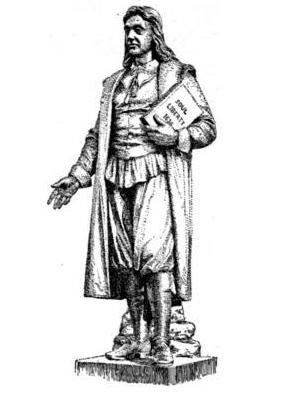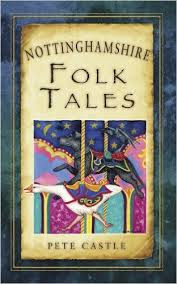The trial
of Jane Wenham for witchcraft in 1712 was one of the last in England
before the passing of the 1736 Witchcraft Act meant witchcraft was no
longer a crime punishable by law. As anyone following here at The
Witch, The Weird, and The Wonderful will know by now, Jane and her
story have fascinated me since I started writing about the goings on
in Walkern for Accused. It was hardly surprising that I got
incredibly excited to learn of the play Jane Wenham: The Witch of
Walkern. Written by Rebecca Lenkiewicz, produced by Out of
Joint and directed by Ria Parry, this superb piece of theatre not
only gives the essential elements of Jane's case an accessible and
thought-provoking spin, but acts as a mirror to the culture and
community of the times of the witch trials in general.
The play
stands out immediately for having a predominately female cast, a rare
enough thing even in this day and age. This isn't just done for
effect: each character is fully-drawn in awe-inspiring detail, and
the play without question passes the bechdel test. There is more than
that however – it isn't by accident that those five characters
represent five separate sub-categories of women – those most likely
to be particularly vulnerable during the time of the witch trials and
beyond, those most likely to be both accusers and accused. For when
tragedy strikes the already unstable community of Walkern, the hunt is on to find someone to blame - someone guilty of both murder and witchcraft.
Jane Wenham and Ann Thorn
The
Cunning Woman:
Common in local communities even into the 20th
century, the cunning woman performed several roles: performing love
magic, locating lost property, providing charms to protect people and animals, and aiding with any number of ailments. They also dealt in counter magic, offering cures for those who
thought themselves bewitched.
In the play, Jane Wenham is portrayed as Walkern's
cunning woman: collecting herbs to make her salves and possets,
snuggling with her chicken James for warmth at night, Jane is seen as
“odd” by her neighbours, but generally tolerated. In the
heightened atmosphere of tension after Elinor Thorn's hanging for witchcraft however
tongues start to wag, and Jane's eccentric behaviour is seen as something more
sinister by the newly arrived Reverend Crane, who sets out to discover her "guilt".
The cunning woman had a somewhat ambiguous role in the community she served. For while she was often seen as a protective and curative force, in times of strain or unrest, or if she failed to help someone who came to her, she could just as quickly come under suspicion herself. It was therefore not unusual for the cunning woman to
become a target for accusations, the line between black magic and the
protective magic she dealt in becoming increasingly blurred. William Perkins condemned all "magic" equally, stating that "by Witches we understand not those only which kill and torment: but all Diviners, Charmers, Juglers, all Wizards, commonly called wisemen and wisewomen."
The
historical Wenham may or may not have fulfilled the role of cunning woman role in the Walkern community, but it is possible that she tried to help Ann Thorn in
some capacity, as the young woman is recorded as having lamented that Jane had "ruined" her.
Historical cunning women accused of witchcraft include potentially Jane Wenham herself and Joan Peterson, the infamous Witch of Wapping.
Hannah Hutch as the troubled Ann Thorne
The Young
Girl:
Girls in their teens play a prominent role in many a witch trial tale, their emotional and biological volatility leaving them, it has been suggested, particularly open to being exploited and to believing their own flights of fancy.
The play opens on Ann Thorn reeling with shock after her
mother is hanged for witchcraft: young, friendless, not knowing which
way to turn, Ann is torn between the seeming support of two local women and her friend Jane Wenham.
Both the stage and historical Ann were instrumental in the accusations against Wenham. Feeling betrayed by her friend after discovering Jane has lied to her regarding her past, Ann turns on the older woman, denouncing her at the urging of the rest of the village and abandoning her to her fate. In the historical story of Jane Wenham, it is Ann Thorn who is one of the earlier to make accusations against Jane Wenham, declaring that the old woman had made her run to collect sticks and sent her into fits.
In addition, Ann of the play has the added taint of
being the daughter of a witch: it was believed that witchcraft passed
through families, as witnessed in the Pendle and Warboys cases among
others. Her mother was also known for her immoral behaviour
throughout Walkern, and her own confused behaviour more than hints at the belief in “like mother, like daughter.”
Reverend Crane and The Widow
The Widow:
Widows were two-a-penny in 17th century England, with women tending to outlive their husbands rather than vice versa throughout the period of the witch trials.
Although
many widows found themselves destitute and beholden to the parish,
Walkern's widow is the landlady of the local alehouse and financially
independent. Anything of importance is discussed within her walls,
and there is little that goes on that she does not know about. Her
unmarried state however leaves her unexpectedly vulnerable; not only
to accusations of immorality due to her affair with a married man,
but also to being a temptation to men such as the virginal Reverend
Crane. A woman with property and not
visibly controlled or protected by a man was ultimately dangerous, leaving her
open to attack.
Widows who were accused of witchcraft include Mother Sutton of Milton Ernest and Mary Lakeland, one of England's few witches to be burned at the stake for the crime of murdering her husband through witchcraft.
Judith Coke as Priddy Goodstern
The Old Woman:
“Old”
did not necessarily mean the same in Jane Wenham's time as it does to us today: then, being
over fifty could mean being labelled or ancient. As with widows, there were many more "ancient" women than there were men and it was a vulnerable position to have indeed: the elderly were more likely to
be in need and to ask for charity from their neighbours, leading to
recriminations and guilt on both sides if requests were refused. Age
and infirmity could also increase irritability and an unpleasant
nature, leading to conflict with one's neighbours.
Walkern's Priddy
Goodstern is not only old but blind, and it is likely that she has often found herself in need of assistance from the community. A
large proportion of women accused of witchcraft were referred to as
“old”, and Priddy is indeed seen meeting with local woman Bridget Hurst and
Ann Thorn and discussing when “the black man” or the Devil has visited her
both as a child and in later life.
Priddy's blindness brings to mind that of Old Demdike, one of the notorious "Pendle" witches.
Kemi Martha and Ann Thorn
The Servant:
A run-down of the women of Walkern would not be complete without mention of the servant, a class known historically for gossiping and being too quick to believe tales of witchcraft and superstition.
A former
slave from Virginia, Kemi Martha now works as housekeeper to the
Bishop. She is free to come and go as she pleases and is paid a
wage, but her position only offers her a certain degree of protection: like other servants at the time, ultimately she is at the mercy of her employer's good will, a fact particularly
starkly represented in Kemi's relationship with the
Bishop. Already the target of gossip due to her skin colour and intimacy with her employer, as tensions begin to rise in the village Kemi finds herself under yet closer scrutiny, relating how, upon rolling a bucket down the hill, Bridget Hurst and Priddy Goodstern whispered about her.
The character of Kemi is particularly reminiscent of Tituba, the "Indian" slave who was accused at the start of the Salem witch trials, twenty years before the events in Walkern. The bucket incident also harks of true events, as the accusation that she had made a bucket run to her down a hill was used against young Mary Spencer in 1634.
Jane Wenham: The Witch
of Walkern is showing at the Arcola Theatre, London, until 30th
January.
My review of the play can be found here.
* All production images copyright
Out of Joint/Richard Davenport





























